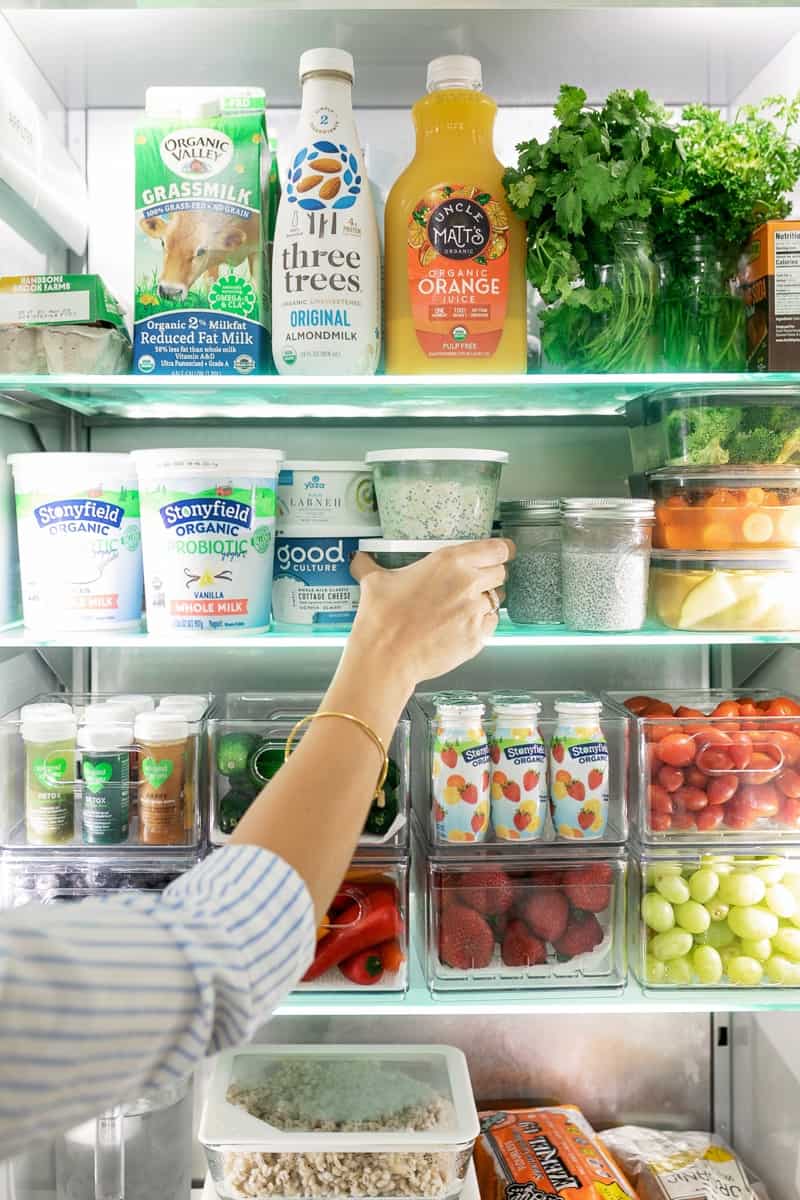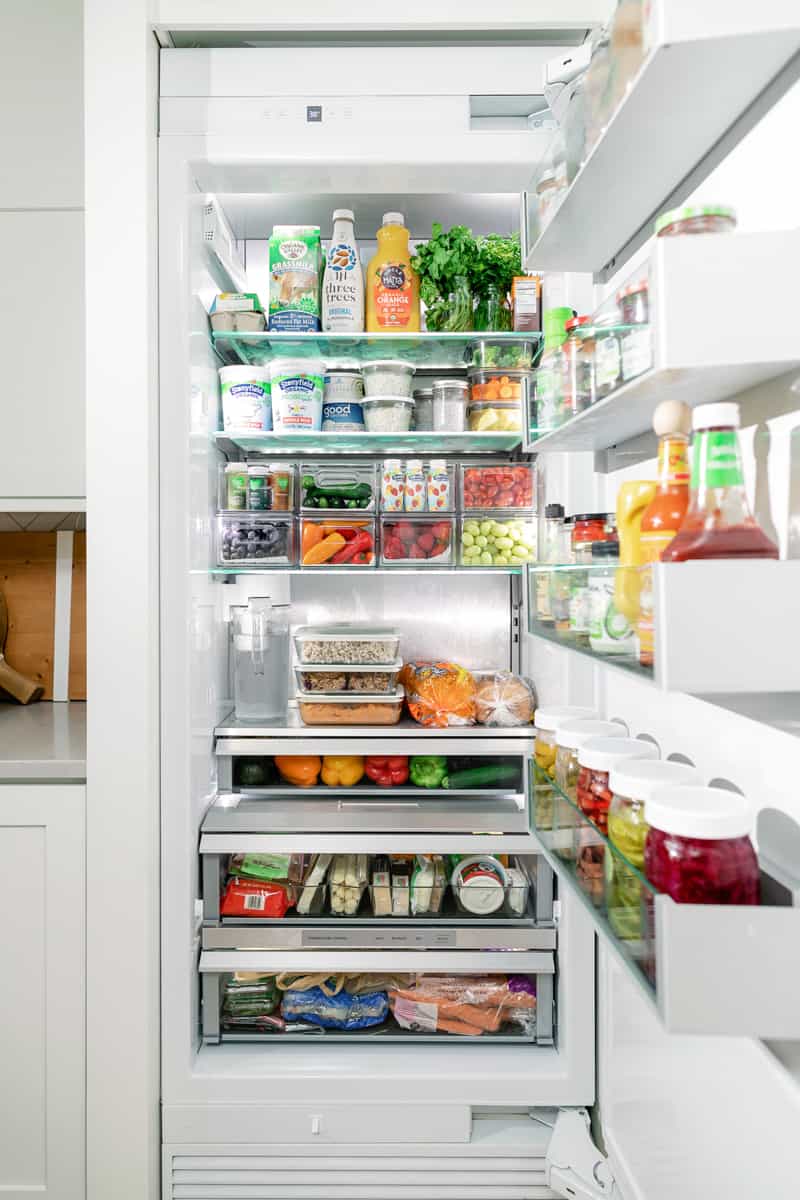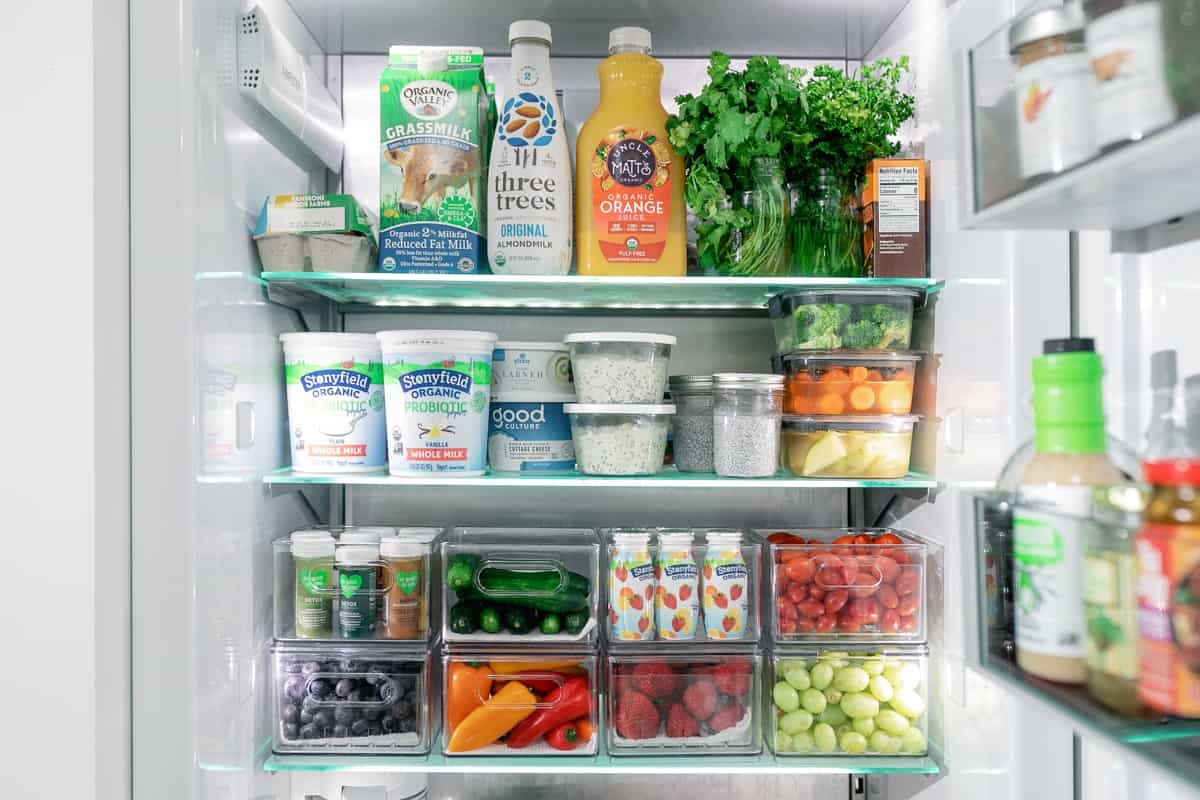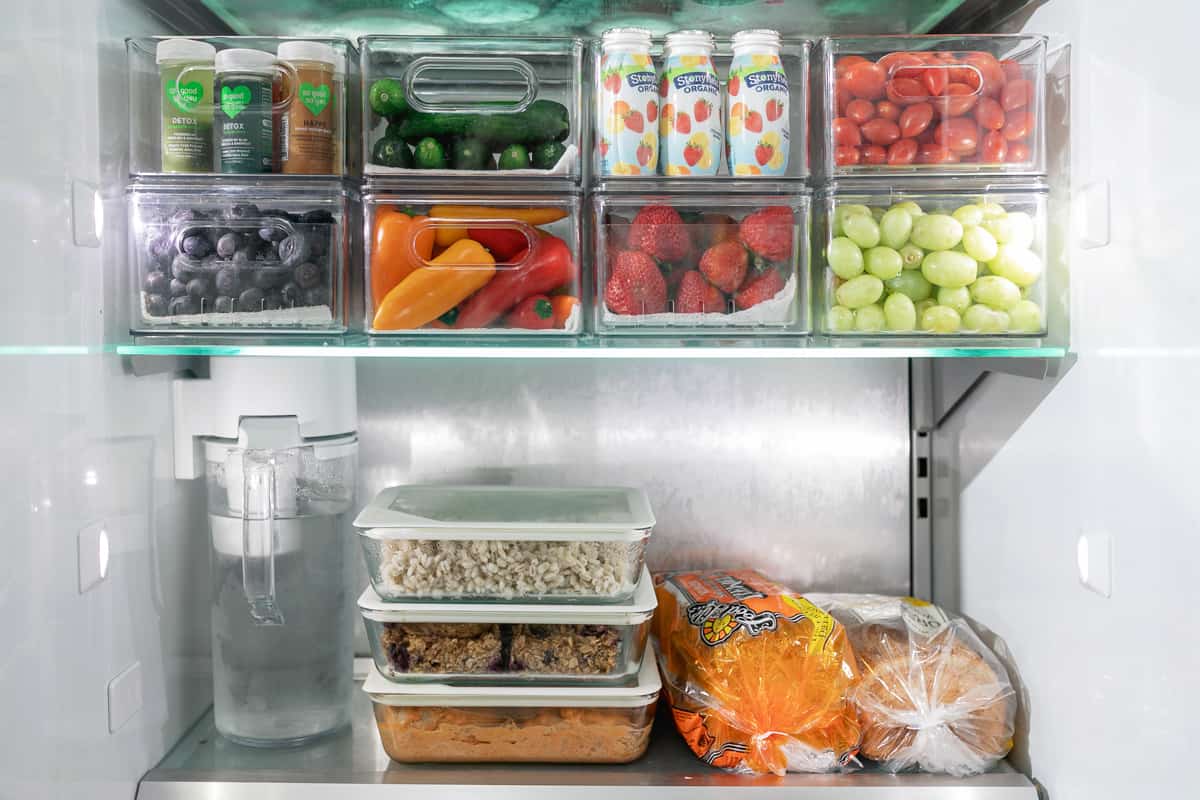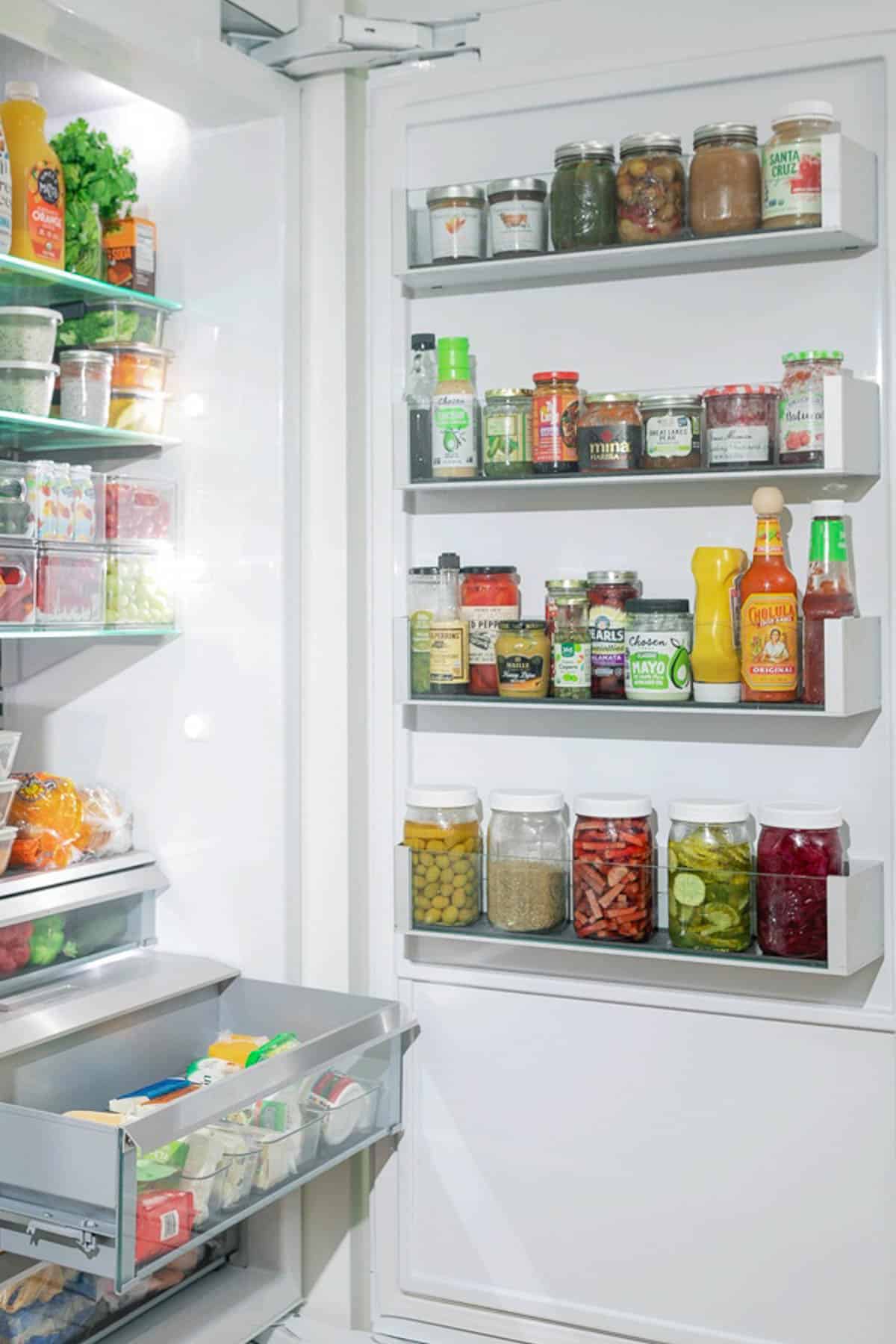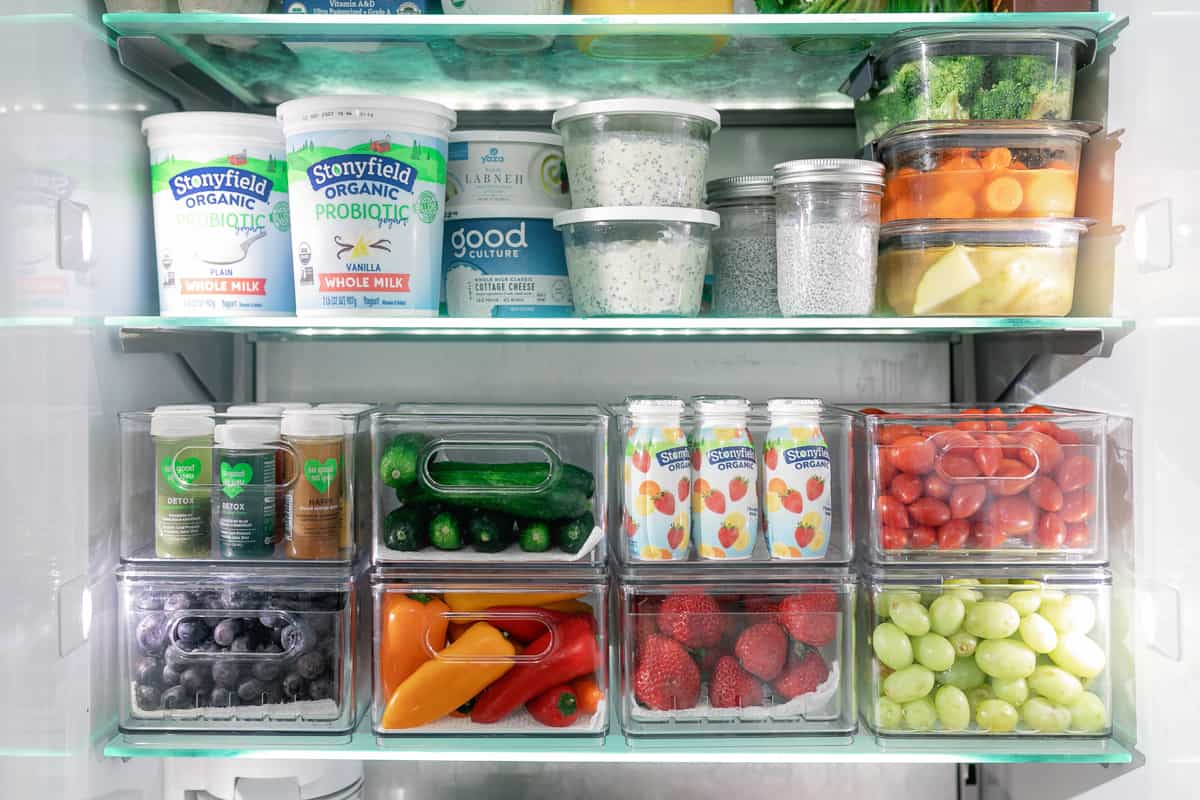Do you know how to organize your fridge? It’s not an easy task to organize it or keep it organized, especially if you have a family. I’ve learned over the years that the best way to organize a fridge and maintain it is to have a place for everything and do regular check-ups. Follow my easy top-down guide on what goes where and why. I’ll include guidelines for how I prefer to organize my fridge and expert tips I’ve learned over the years to maximize space and reduce waste. So, how do you organize your fridge? Are you a smoosh-it-all-in-and-hope-for-the-best type or do you arrange items with Pinterest-ready precision, containers labeled and dated? There is scientific reasoning behind organizing your fridge for maximum chill!
Best Ways to Organize Your Fridge
This is how I organize my fridge to help make my time in the kitchen more efficient. Knowing what you have and where it is kept dramatically decreases the time it takes to make meals! Store your produce safely this way by keeping foods separate so that nothing is contaminated.
Upper shelves
Just like your oven has hot spots, the fridge has gradations in temperature especially because heat rises. The upper shelves are the warmest, which makes them best for:
Eggs: Contrary to the way some fridges are designed with egg compartments on the door, eggs actually do better on the second shelf where the temp is cold and stable. Milk: Avoid putting milk on the refrigerator door. That is the warmest place in the refrigerator, and milk needs to be kept colder. Since I put cow’s milk at the top, I like to leave plant-based milk like almond milk and oat milk next to it for convenience. Juice: Unpasteurized fresh-squeezed juices should go next to the milk, and even when it’s not pasteurized, I like to keep the juice next to the milk for convenience. All other juices, bottled water, and soda can go in the fridge door. Fresh herbs: For the herbs I use most often, I treat them like flowers and place them in a small jar filled with water. You can keep them uncovered for a week or cover them with a plastic bag or damp paper towels to last for 2-3 weeks! Cultured Dairy: This includes Greek yogurt, plain yogurt, cottage cheese, ricotta, sour cream, and labneh, all of which are great for bulking up recipes with an added dose of protein and flavor. I will often include chia pudding and overnight oats in this fridge shelf as well since they are made with milk and/or yogurt and are easy to grab from here. Baking Soda: A box of baking soda in the fridge neutralizes food odors, so I always keep mine stashed in there. It can really go anywhere in the fridge and works well when you need it for baking.
Lower shelves
We’re getting colder as we go lower in fridge organization! How you organize this tier depends on whether or not your fridge comes with designated meat and produce drawers.
Ready-To-Eat Snacks: If you have small children and they are allowed to help themselves to snacks, keep those items in front of the fridge at their eye level – maybe the second shelf from the top in front- where they can easily see and reach them independently. This is where I like to include smoothie yogurts, single-serve juices, and fruits and vegetables that are washed and ready for snacking, including berries, grapes, tomatoes, sweet peppers, cucumbers, carrots, and broccoli. Pre-cooked food: This includes leftovers from meals you’ve made or ready-made meals like baked oatmeal or cooked grains like farro. I also include any foods I’m marinating (like my yogurt marinated chicken) or thawing in this section so I can easily access them for dinner time. Bread: We prefer to refrigerate our bread, and if you do too, place it on the lower shelves. Produce: If you don’t have produce drawers, you’ll also want to store your uncooked fruits and vegetables as low as possible. Separate veggies from fruits, many of which emit ethylene, which prematurely wilts vegetables. If needed, create your own produce drawers with containers (see below).
Drawers
Use your designated drawers for their purpose – unless, say, you are a vegetarian and can repurpose the meat storage. Here are the three popular drawers available on most fridges:
Meat and Poultry Drawer: Do not waste this specially designed place on cans of soda. Some refrigerators even pipe colder air into the meat drawers to create the lowest, safest temps possible. This keeps them cold and minimizes the possibility of contamination of items below, should the packaging leak. I keep my meat, poultry, and seafood in the freezer, so I usually only have 1-2 items of these thawing for the week, and I prefer to wrap them individually so they don’t contaminate the produce around them. Produce Drawers/Crispers: Separate fruit and veggies to prevent the ethylene fruits from wilting the veggies. Some models allow you to control the humidity. Vegetables like higher humidity. And fruits like lower humidity. Crispers work best when they are three-quarters full. Since I have a shallow and deep drawer, I use the shallow one more for fruits, tomatoes, peppers, and the deeper ones for cruciferous vegetables and root vegetables that take up more space.
Cheese & Butter: I have an entire fridge drawer dedicated to cheese, which I know is not common. But if you eat a lot of cheese like we do, keep them all together in a drawer so they don’t get lost in deep shelves. I like to stock semi-soft cheeses such as Havarti, Gouda, or mozzarella; halloumi, a great semi-hard cheese for grilling and searing; a hard cheese like aged Parmesan; soft, spreadable cheeses like Boursin, cream cheese, or La Vache Qui Rit; sticks and cubes of snacking cheeses for my two kids; and, of course, feta, because it makes everything betta.
Door(s)
Every time you open the fridge door, the items on the door get a blast of heat. Therefore, doors are excellent storage for shelf-stable items you want to chill – like juice or water – and items, typically with high sugar or vinegar naturally preserving content that inherently have a long life.
Jams, jellies and applesauce. (store-bought and sometimes homemade too) Condiments: This includes ketchup, yellow mustard, Dijon mustard, hot sauce, salad dressings, sun-dried tomatoes, roasted red peppers, harissa, mayonnaise, soy sauce, Worcestershire sauce, oyster sauce, and maple syrup. Pickled Products: I love a variety of pickles to spice up any meal, so my fridge usually includes pickled turnips, pickled onions, sliced dill pickles, cornichons, capers, banana peppers, and a variety of olives, including green olives (such as Castelvetrano or Cerignola), Kalamata olives, and oil-cured black olives. Za’atar: Za’atar seasoning is a spice made with dried oregano, sumac, sesame seeds, and salt. You can make it at home, but I find that the best zaatar comes from Lebanon, and I keep it in giant mason jars in my fridge so it lasts longer.
Useful Fridge Organizers
Tips for keeping the fridge organized
Organizing your fridge is a way of protecting the investment you make at the grocery store and preventing food waste. Plus, it just feels good to be organized and have a place for everything in your fridge – I know, easier said than done, especially with a family!
For more organization resources:
How to Stock your Pantry How to Stock a Freezer Food Storage Tips How to make your kitchen more efficient
If you find these tips for How to Organize your Fridge, I’d love to hear from you! And if you snapped some shots of any of these tips and tricks, please share it with me on Instagram so I can repost on my stories!
